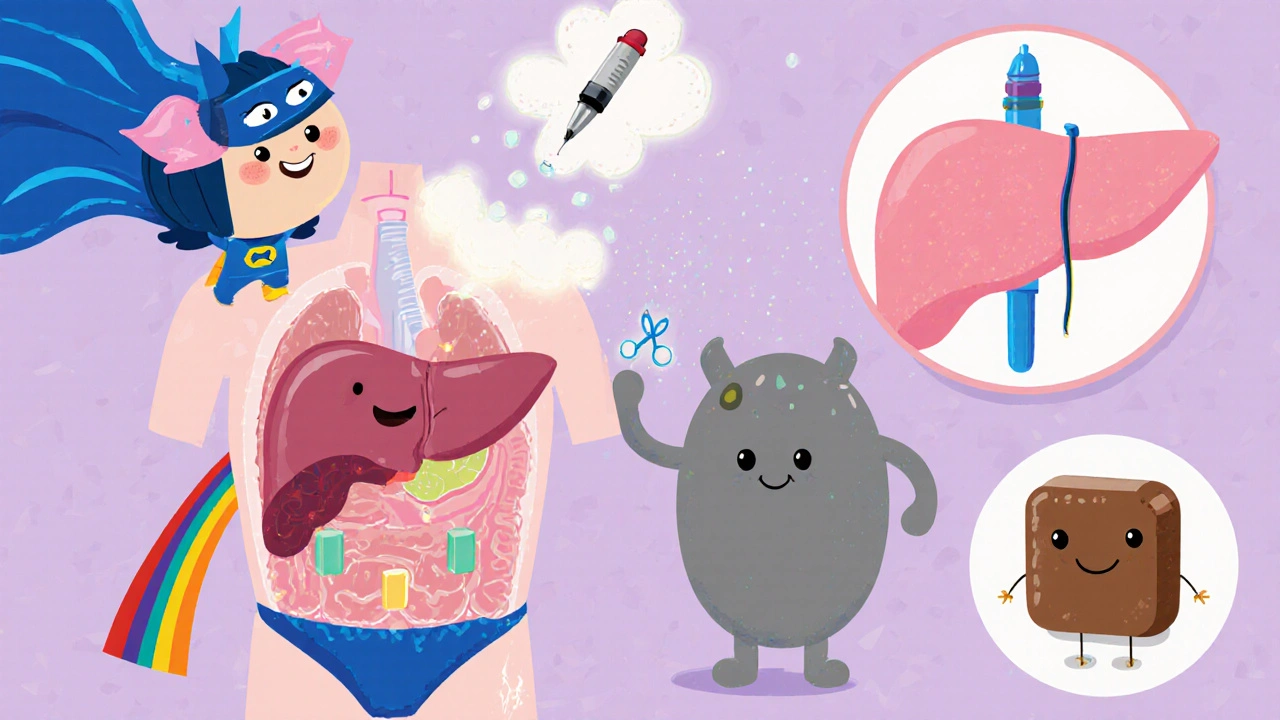When managing type 2 diabetes, finding the right pill can feel like a maze. Onglyza is a prescription oral medication whose active ingredient is saxagliptin, a dipeptidyl peptidase‑4 (DPP‑4) inhibitor that helps the body release more insulin after meals. If you’re weighing Onglyza against other options, start by understanding how it works, who benefits most, and where it stands next to its peers.
How DPP‑4 Inhibitors Like Onglyza Work
DPP‑4 is an enzyme that breaks down incretin hormones (GLP‑1 and GIP). Those hormones normally tell the pancreas to release insulin and tell the liver to cut down glucose production. By blocking DPP‑4, saxagliptin keeps incretins active longer, leading to smoother post‑meal blood‑sugar control without a big risk of hypoglycemia.
Key attributes of the DPP‑4 class:
- Oral, once‑daily dosing.
- Weight‑neutral for most patients.
- Low risk of severe low blood sugar unless combined with sulfonylureas or insulin.
Major Alternatives to Consider
While DPP‑4 inhibitors are popular, several other drug families offer comparable or stronger HbA1c reductions, different side‑effect profiles, and varied cost structures.
Other DPP‑4 Inhibitors
Januvia (sitagliptin) and Tradjenta (linagliptin) share the same mechanism as Onglyza but differ in metabolism and dosing nuances. Januvia is cleared by the kidneys, so dose adjustments are needed in renal impairment, whereas Tradjenta is largely hepatic and can be used without adjustment in most kidney stages.
GLP‑1 Receptor Agonists
Victoza (liraglutide) and Ozempic (semaglutide) mimic the incretin effect directly. They are injectable, produce more pronounced weight loss, and can lower HbA1c by up to 1.5% in some patients. The trade‑off is the need for injections and a higher price tag.
SGLT2 Inhibitors
Jardiance (empagliflozin) works in the kidneys to push excess glucose out in the urine. Benefits include modest weight loss, blood‑pressure reduction, and proven cardiovascular protection. Side effects can include urinary tract infections and rare ketoacidosis.
Biguanides
Metformin remains the first‑line oral agent for most newly diagnosed patients because it lowers hepatic glucose output, improves insulin sensitivity, and is inexpensive. It can cause gastrointestinal upset and, rarely, lactic acidosis.
Sulfonylureas
Glipizide stimulates the pancreas to release insulin regardless of blood sugar levels, offering strong HbA1c reductions but a higher risk of hypoglycemia and weight gain.
Pros and Cons of Onglyza
Pros
- Once‑daily oral tablet - no injections.
- Generally weight‑neutral.
- Low hypoglycemia risk when used alone.
- Effective in patients with moderate renal impairment (dose reduction needed only when eGFR <30mL/min).
Cons
- HbA1c reduction typically 0.5-0.8% - less than many GLP‑1 agonists.
- Higher cost than generic metformin or sulfonylureas.
- Rare reports of heart failure exacerbation; FDA added a boxed warning in 2024.

Decision Checklist: When to Choose Onglyza
- Patient prefers an oral option and fears injections.
- Weight management is a priority and weight gain must be avoided.
- Current regimen includes metformin, and we need an add‑on with low hypoglycemia risk.
- Renal function is mildly reduced (eGFR 30-60mL/min) where other DPP‑4 agents might need dose cuts.
- Cost is acceptable within the patient’s insurance or government subsidy plan.
Side‑Effect Profile and Safety Considerations
Common mild events (<5% incidence) include upper‑respiratory infections, headache, and nasopharyngitis. Serious concerns are:
- Heart failure: clinical trials observed a slight increase in hospitalization for heart failure; monitor patients with existing cardiac disease.
- Pancreatitis: rare but should be ruled out if the patient reports severe abdominal pain.
- Hypersensitivity reactions: rash or angioedema may require discontinuation.
Monthly labs are not required, but checking renal function annually is good practice.

Cost Comparison (2025 US Prices)
| Drug | Class | Typical HbA1c ↓ | Weight impact | Average monthly cost (USD) | FDA approval year |
|---|---|---|---|---|---|
| Onglyza (saxagliptin) | DPP‑4 inhibitor | 0.5-0.8% | Neutral | $210 | 2015 |
| Januvia (sitagliptin) | DPP‑4 inhibitor | 0.5-0.9% | Neutral | $160 | 2006 |
| Victoza (liraglutide) | GLP‑1 agonist | 1.0-1.5% | Weight loss (~3kg) | $950 | 2010 |
| Jardiance (empagliflozin) | SGLT2 inhibitor | 0.5-0.8% | Weight loss (~2kg) | $420 | 2014 |
| Metformin | Biguanide | 0.5-1.0% | Neutral/ slight loss | $4 (generic) | 1995 (generic) |
| Glipizide | Sulfonylurea | 0.8-1.5% | Weight gain (~1-2kg) | $30 (generic) | 1995 (generic) |
Practical Tips for Switching or Adding Onglyza
- Start at 5mg once daily; increase to 10mg if HbA1c remains above target after 12 weeks.
- When adding to metformin, no dose adjustment is required for either drug.
- If the patient is already on a sulfonylurea, consider lowering that dose to avoid hypoglycemia.
- Educate patients about the signs of pancreatitis (severe abdominal pain radiating to the back).
- Schedule a follow‑up visit in 3 months to review A1c and evaluate any side effects.
Frequently Asked Questions
Can I take Onglyza with insulin?
Yes. Onglyza can be combined with basal or mealtime insulin. Because the drug itself does not cause low blood sugar, the risk of hypoglycemia mainly comes from the insulin dose, so clinicians often reduce the insulin amount when adding saxagliptin.
Is Onglyza safe for people with kidney disease?
Saxagliptin is cleared partly by the kidneys. For patients with an eGFR between 30 and 60mL/min, the standard 5mg dose is still acceptable, but if eGFR falls below 30, the dose should be reduced to 2.5mg daily.
How does Onglyza compare to Januvia?
Both belong to the DPP‑4 class and lower HbA1c by about 0.5-0.9%. The main difference is metabolism: saxagliptin (Onglyza) has a longer half‑life, allowing consistent once‑daily dosing, while sitagliptin (Januvia) requires renal dose adjustments.
Why does the FDA warn about heart failure with Onglyza?
A post‑marketing clinical trial (SAVOR‑TIMI 53) observed a modest increase in hospitalizations for heart failure among patients on saxagliptin. The warning advises clinicians to monitor patients with existing cardiac disease closely.
What should I do if I miss a dose?
Take the missed tablet as soon as you remember, unless it’s almost time for the next dose. In that case, skip the missed one and continue with the regular schedule. Do not double‑dose.
Choosing the right diabetes medication often feels like a balancing act between efficacy, safety, cost, and lifestyle. Onglyza offers a convenient, weight‑neutral option that slots neatly between metformin and the more aggressive GLP‑1 or SGLT2 agents. By weighing the checklist above and discussing personal priorities with a healthcare provider, patients can land on a regimen that fits their daily routine and long‑term health goals.






Hey folks, just wanted to drop a quick note that DPP‑4 inhibitors like Onglyza can be a solid choice for many people with type 2 diabetes. They're easy to take once a day and most patients don’t see any weight gain. I also like that the risk of severe low blood sugar is pretty low when you’re not on insulin or sulfonylureas. If you’re worried about kidney issues, just remember the dose can be tweaked and it’s still safe for moderate impairment. Hope this helps, stay healthy :)